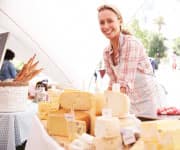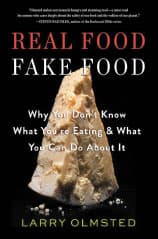Life Extension Magazine®
The secrets, lies, and outright fraud uncovered by award-winning journalist Larry Olmsted in his book Real Food/Fake Food are downright shocking. “We absolutely should be alarmed by the latest food scandal, but we should not be surprised,” he says.
“We have incompetent FDA oversight. We have criminal, negligent or immoral producers of wine, cheese, oil, meat, and more. But the real scandal here is that many of us have never actually tasted the real things.”
The inspiration for Olmsted’s book can be traced back to a visit he took to Japan years ago, during which he sampled that country’s world-renowned Kobe beef, with which he was much impressed with.
After returning to the US, he found that the so-called Kobe beef available here was dramatically inferior to what he’d enjoyed in Japan. A little research quickly uncovered the reason for the difference—the US Department of Agriculture (USDA) had banned the import of Kobe beef years earlier. Clearly, all of the “Kobe beef” sold in America was not what it was purported to be. Olmsted began to wonder how many other foods sold in the US might be fake. In the course of writing and researching his book, he found that “the unfortunate answer is a lot.”

LE: What exactly do you mean when you label much of the food in the US as “fake?”
LO: When I say fake, I mean fake, as in not what you think you are buying or eating… I’m talking about a massive industry of bait and switch, where you get something other than promised. I don’t like industrially produced supermarket beef, but it is in fact beef, and lives up to that billing. But when the same drug-laden, artificially fed beef is passed off as “natural,” “grass fed,” or “pure,” then it becomes fake—it is no longer what it claims to be.
LE: You write that many people spend hundreds of dollars on a single steak that is sold to them as Kobe beef when it isn’t. How can the government allow that kind of fraud to go unchecked?
LO: As a matter of policy, the US Food and Drug Administration (FDA) does not police most food fraud, and it hardly matters because most Kobe scams occur at restaurants, which are largely exempt from labeling laws. So they almost always get away with it.
LE: Are there other types of food that are as fraudulent?
LO: The seafood industry is far worse than beef, so rife with fakery, both legal and illegal, that it boggles the mind. Suffice it to say, if you think you are buying or eating red snapper—ever—you might want to think again. Several recent studies put the chances of your getting the white tuna you ordered in the typical New York sushi restaurant at zero—as in never. Wild-caught salmon? Wild-caught anything? Maybe not… It’s easy to take a “so what?” attitude when you order one kind of fish and get another, until you consider that the fake is likely pumped full of drugs and antibiotics—sometimes banned and illegal—none of which would have been in the fish you actually ordered. Not all fake foods are harmless, and many are disgusting.
LE: In your book, you go into quite a bit of detail discussing olive oil.
LO: Real extra-virgin olive oil is just about the healthiest fat on the market, yet most bottles sold in this country are fake. The imposters have often been stripped of their health benefits—and some might not even be made from olives. This is one of the most pervasive fake foods in America, reaching deep into home kitchens, restaurants, and supermarkets, and not unfamiliar to the government agencies supposedly watching over the food supply.
LE: Is there a noticeable difference between the taste of fake olive oil and the real thing?
LO: When I tasted oil in Puglia (at an artisanal olive farm in Italy), it left a warm tickle in the back of my throat, a sensation I would later learn is called olive sting. It is an indicator of freshness—and largely absent in oils sold in the United States. While it has become ubiquitous for American restaurants to stuff patrons with a basket of bread and a bowl of golden-colored oil for dipping, that liquid is so far removed from the real thing as to be unrecognizable.
LE: Besides taste, what is the public being deprived of when they consume fake or inferior olive oil?
LO: Real olive oil is low in saturated fat and high in monounsaturated fatty acids that reduce the risk of heart disease. Unlike vegetable oils, such as canola, olive oil also has additional beneficial properties, such as antioxidants and polyphenols, anti-inflammatory compounds that promote a healthful cardiovascular system.

LE: Olive oil has been the subject of a large number of studies over the years. Can you expand on what those studies have discovered?
LO: Reputable claims include fighting some forms of cancer, assisting in the assimilating of vitamins, fostering good digestion, and lowering blood cholesterol. It is higher in oleic acid than any vegetable oil, and this monounsaturated acid helps reduce the risk of cardiovascular disease (oleic acid is found in the highest concentrations in real extra virgin).
Extra virgin olive oil also contains sterols and the liposoluble vitamins A, D, and E, to which have been attributed a protective and antioxidant action that may prevent artery-blocking deposits and cancer and slow the aging process. Antioxidants, including polyphenols, are also believed to act as antitumoral agents. A more recently isolated substance in olive oil, dubbed oleocanthal, was shown to reduce the adverse effects of amyloid-beta-derived diffusible ligands, suspected of contributing to Alzheimer’s disease… Unfortunately, most of the health benefits disappear in fake olive oil.
LE: How pervasive is fake olive oil?
LO: In 2010, the University of California-Davis Olive Center tested supermarket samples and concluded that more than two-thirds of imported oils (69%) labeled “extra virgin” were not.
LE: What exactly did they conclude?
LO: “These failed samples had defective flavors such as rancid, fusty and musty…Chemical testing indicated that the samples failed extra virgin standards for reasons that include adulteration with cheaper oils; poor quality oil made from damaged and overripe olives, processing flaws, and/or improper oil storage.”
LE: What should consumers who want to get the real thing look for when purchasing olive oil?
LO: The most important thing you can find is the harvest date... Ignore meaningless “best by” or “bottled on” dates. “Extra virgin” is no guarantee, but its absence on a bottle is a guarantee of inferiority. Don’t ever buy anything labeled “virgin,” “pure,” “light,” “extra light,” “olive oil blend,” Mediterranean blend,” or simply, “olive oil.”

LE: You write that authentic, original Parmesan cheese—Parmigiano-Reggiano—comes from a legally designated zone in Italy around the towns of Parma and Reggio. So what are we usually getting in the US?
LO: Most “Parmesan” cheese is a blatant counterfeiting of Parma’s product, best exemplified by the ubiquitous Kraft grated version that comes in green cardboard tubes and tastes like what you would get if you ground up green cardboard tubes. This may not be as far from reality as it sounds. In early 2016, the FDA showed that Parmesan fraud has become a very serious problem for American consumers. Its tests showed that products described as “100% Parmesan” are routinely cut with cheaper products, and not just less expensive cheeses, but also wood pulp. Tests by Bloomberg News showed that Kraft Parmesan contained almost 4% cellulose, a plant-derived polymer mainly used to make paper and paperboard. Other brands had cellulose content as high as 7.8%.
LE: In general, what can consumers do to eat more real food and less fake food?
LO: The answer is twofold: shop better and cook more. You have more control over the final product if you make it than if you buy it made. In general, I suggest shopping at better stores, whether it is Whole Foods, Trader Joe’s, Costco, or the local fishmonger you trust. Cooking is the easiest solution to eating more real food at home. Despite the extra labor and time, in many cases doing it yourself pays off.

The single biggest shopping rule is to read ingredient labels carefully. The sheer number of components in heavily processed foods is a problem, as each can hide unsavory things, as well as where they came from. To me there is just something intrinsically wrong about eating a lot of unnecessary chemicals. It’s worth the time to cook real foods. It is also worth the effort to shop for them and worthwhile to support the real people who make them. Keep it real.
Larry Olmsted writes the “Great American Bites” column for USA Today and his food and travel column appears on Forbes.com. His expose on counterfeit Kobe beef for Forbes.com was widely covered by newspapers, websites, and radio shows around the world. Olmsted is the author of two books on golf and, most recently, Getting into Guinness, during the writing of which he set or broke three world records himself.
If you have any questions on the scientific content of this article, please call a Life Extension® Wellness Specialist at 1-866-864-3027.
To order Real Food/Fake Food, call 1-800-544-4440 or visit www.LifeExtension.com

